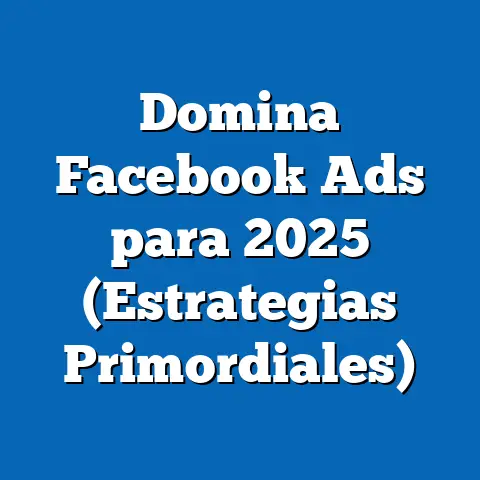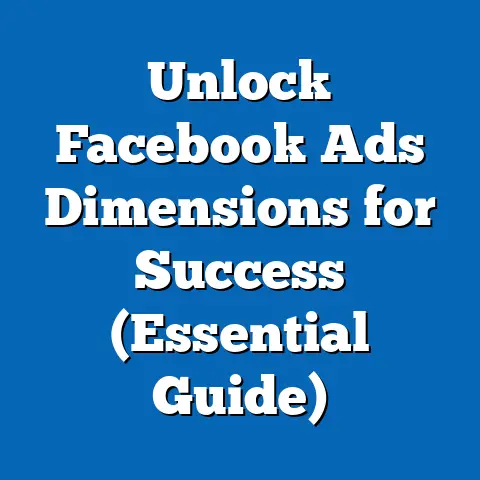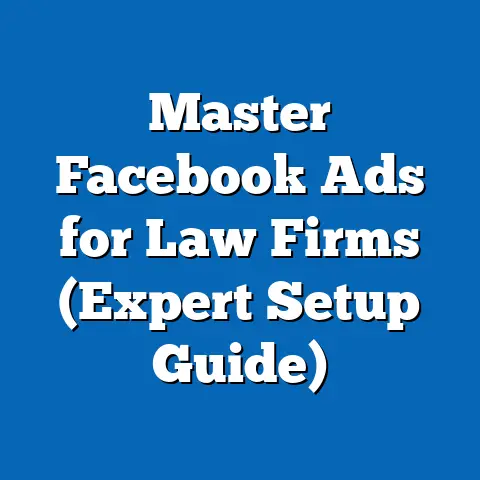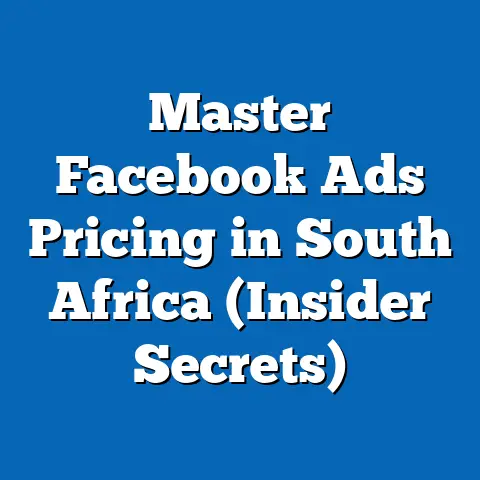Revamp Poor Facebook Ads for Higher Conversions (Pro Tips)
In the ever-evolving landscape of digital marketing, Facebook remains a dominant platform for businesses to reach diverse audiences. However, crafting effective ads that resonate with specific demographics—particularly in the luxury sector—requires a nuanced understanding of both the target audience and the platform’s capabilities. Luxury brands, with their unique positioning, face distinct challenges and opportunities when advertising on social media, where broad accessibility can sometimes clash with the exclusivity that defines high-end products and services.
Historically, luxury brands relied on traditional media—print magazines, billboards, and television—to craft an aura of sophistication and inaccessibility. The shift to digital platforms like Facebook in the early 2000s marked a turning point, as brands had to balance maintaining exclusivity with the mass reach of social media. This transition was not without challenges; early digital ads often failed to capture the essence of luxury, appearing too generic or overly promotional, which risked diluting brand prestige.
The societal implications of targeting luxury consumers through platforms like Facebook are significant. On one hand, digital advertising has made luxury more accessible, allowing brands to engage with a broader audience and foster brand loyalty among younger generations. On the other hand, it raises questions about overexposure and the potential erosion of exclusivity—a core tenet of luxury. As we move forward, understanding these dynamics will be crucial for crafting ads that resonate without compromising brand identity.
Section 2: Challenges of Facebook Ads for Luxury Brands
Advertising luxury products on Facebook presents unique hurdles. Unlike mass-market brands, luxury businesses cannot rely on broad, volume-driven campaigns; their messaging must evoke emotion, aspiration, and scarcity. Poorly performing ads often fail to address these elements, resulting in low engagement and conversion rates.
One common issue is visual inconsistency. Luxury is inherently tied to high-quality aesthetics, yet many brands use generic stock imagery or low-resolution visuals in their ads, undermining their premium positioning. A 2021 study by Socialbakers found that ads with high-quality, branded visuals achieved 67% higher click-through rates (CTR) compared to those with generic imagery.
Another challenge is targeting. Luxury consumers are a niche audience, and overly broad targeting can lead to wasted ad spend and irrelevant impressions. Conversely, overly narrow targeting may exclude potential aspirational buyers who could convert over time. Striking the right balance requires leveraging Facebook’s advanced targeting tools while maintaining a deep understanding of consumer psychographics.
Finally, tone and messaging often miss the mark. Luxury ads that focus solely on product features or discounts can feel transactional, alienating an audience that values storytelling and emotional connection. Addressing these pain points is the first step toward revamping underperforming ads.
Section 3: Pro Tips for Revamping Poor Facebook Ads for Luxury Brands
To transform lackluster Facebook ads into high-converting campaigns, luxury brands must adopt a strategic, data-driven approach. Below are expert-backed tips tailored to the unique needs of the luxury sector, ensuring both brand integrity and measurable results.
3.1 Craft Visually Stunning Creatives
Visuals are the cornerstone of luxury advertising. Invest in high-quality photography or videography that showcases the craftsmanship, heritage, and exclusivity of your product. For instance, a luxury watch brand might use close-up shots of intricate mechanisms or lifestyle imagery of the watch in elite settings.
Incorporate consistent branding elements—logos, color schemes, and typography—to reinforce brand identity. A 2020 report by Nielsen found that consistent branding across platforms increases ad memorability by 23%. Test carousel ads or video formats to tell a story, as these formats often outperform static images in engagement metrics.
3.2 Leverage Precise Audience Targeting
Facebook’s targeting capabilities allow brands to reach specific demographics based on income, interests, and behaviors. For luxury brands, consider targeting high-net-worth individuals through lookalike audiences based on existing customers or using interest-based targeting for categories like fine dining, travel, and fashion.
Don’t overlook aspirational consumers. Use dynamic ads to retarget users who have interacted with your website or social pages, offering entry-level luxury products or limited-time experiences to build long-term loyalty. According to Facebook’s internal data, retargeting campaigns can boost conversion rates by up to 70%.
3.3 Focus on Storytelling Over Selling
Luxury consumers buy into a lifestyle, not just a product. Use ad copy and visuals to tell a story about your brand’s heritage, values, or the experience of ownership. For example, a luxury car brand might highlight the thrill of driving through scenic landscapes rather than focusing on technical specifications.
Avoid overt calls-to-action like “Buy Now” in favor of subtle invitations such as “Discover More” or “Experience Elegance.” A 2019 study by Kantar revealed that ads with emotional storytelling outperformed transactional ads by 31% in terms of brand favorability among affluent audiences.
3.4 Optimize for Mobile and Use Interactive Formats
With over 98% of Facebook users accessing the platform via mobile devices, optimizing ads for smaller screens is non-negotiable. Ensure that visuals and text are legible on mobile, and use vertical or square formats for better visibility in the feed. Interactive formats like polls, quizzes, or augmented reality (AR) experiences can also drive engagement, especially among younger luxury consumers.
For instance, a luxury beauty brand might use an AR filter to let users virtually try on makeup shades, creating a personalized and memorable interaction. Facebook reports that AR ads can increase purchase intent by 53% compared to standard ads.
3.5 Test and Iterate with Data-Driven Insights
A/B testing is critical for identifying what resonates with your audience. Test different visuals, copy variations, and audience segments to uncover winning combinations. Use Facebook’s Ads Manager to track key performance indicators (KPIs) like CTR, cost-per-click (CPC), and return on ad spend (ROAS).
Luxury brands should also monitor qualitative feedback, such as comments and direct messages, to gauge sentiment. A 2022 HubSpot survey found that 68% of marketers who regularly analyze ad performance data achieve higher conversion rates than those who don’t.
3.6 Incorporate Social Proof and Exclusivity
Luxury consumers value social validation and scarcity. Highlight testimonials, celebrity endorsements, or user-generated content (UGC) to build trust. For example, featuring a well-known influencer wearing your product can enhance credibility.
Create a sense of urgency by promoting limited-edition products or exclusive offers. Phrases like “Limited Availability” or “Only for a Select Few” tap into the fear of missing out (FOMO), a powerful motivator for luxury buyers. A study by Eventbrite found that 69% of consumers are more likely to purchase when they perceive scarcity.
3.7 Align Ads with Cultural and Seasonal Trends
Luxury brands must stay attuned to cultural moments and seasonal events that resonate with their audience. Tailor campaigns around holidays like Christmas or cultural phenomena like fashion weeks to capture attention. For instance, a luxury jewelry brand might launch a Valentine’s Day campaign emphasizing romance and gifting.
Ensure that messaging reflects current societal values, such as sustainability or inclusivity, which are increasingly important to younger luxury consumers. A 2021 McKinsey report noted that 60% of Gen Z luxury buyers prioritize brands with strong ethical practices.
Section 4: Societal and Economic Implications of Luxury Advertising on Facebook
The rise of digital advertising for luxury brands has far-reaching implications for society and the economy. On a societal level, the accessibility of luxury through platforms like Facebook has blurred the lines between exclusivity and mass appeal. While this democratization can empower aspirational consumers, it also risks diluting the prestige associated with luxury, potentially alienating core high-net-worth clients.
Economically, the luxury sector’s investment in digital advertising contributes significantly to the growth of the digital economy. According to eMarketer, luxury brands are projected to spend over $30 billion on digital ads by 2025, with social media platforms like Facebook capturing a substantial share. This shift creates opportunities for tech companies, content creators, and marketers while driving innovation in ad technology.
However, there are challenges to consider. The reliance on data-driven targeting raises privacy concerns, as luxury consumers often value discretion. Brands must navigate these concerns by prioritizing transparency and adhering to regulations like GDPR. Additionally, the environmental impact of digital advertising—through server energy consumption—contrasts with the growing demand for sustainability in luxury, creating a tension that brands must address.
Section 5: Generational Dynamics in Luxury Advertising on Facebook
Understanding generational differences is key to crafting effective luxury ads on Facebook. Baby Boomers, often high-net-worth individuals, value tradition and quality, responding well to ads that emphasize heritage and craftsmanship. Millennials, on the other hand, prioritize experiences and authenticity, gravitating toward brands that align with their values, such as sustainability.
Gen Z, the youngest luxury consumer segment, is digitally native and highly engaged on social media. They seek personalization and interactivity, making formats like AR and influencer collaborations particularly effective. A 2022 Deloitte study found that 40% of Gen Z luxury buyers discover brands through social media, compared to just 15% of Boomers.
Despite these differences, there is diversity within each generation. Not all Millennials are aspirational buyers, and not all Boomers are affluent. Luxury brands must use data to segment audiences effectively, avoiding stereotypes and tailoring campaigns to individual preferences.
Section 6: Case Studies of Successful Luxury Facebook Ad Campaigns
To illustrate the effectiveness of the strategies outlined, let’s examine two case studies of luxury brands that revamped their Facebook ads for higher conversions.
Case Study 1: Burberry’s Storytelling Campaign Burberry, a British luxury fashion house, struggled with low engagement on early Facebook ads due to overly promotional messaging. In 2020, the brand shifted to a storytelling approach, launching a campaign that highlighted its iconic trench coat through a short video depicting its history and cultural significance. The ad achieved a 45% higher CTR and a 30% increase in conversions compared to previous campaigns, demonstrating the power of narrative.
Case Study 2: Rolex’s Exclusive Launch Event Rolex used Facebook to promote a limited-edition watch launch, targeting high-net-worth individuals and watch enthusiasts with precise lookalike audiences. The ad featured a countdown to an exclusive virtual unveiling event, creating urgency and exclusivity. The campaign resulted in a 50% increase in event sign-ups and a significant boost in direct sales, showcasing the impact of scarcity-driven messaging.
Section 7: Measuring Success and Key Metrics for Luxury Ads
Tracking the performance of Facebook ads is essential for continuous improvement. For luxury brands, traditional metrics like CTR and CPC remain important, but they should be complemented by brand-specific KPIs such as brand lift, engagement rate, and customer lifetime value (CLV).
Use Facebook’s Brand Lift Studies to measure changes in brand awareness and perception post-campaign. Monitor engagement metrics like shares and comments to gauge emotional resonance. Additionally, track CLV to assess the long-term impact of acquiring new luxury customers, as repeat purchases are often more valuable than one-time sales in this sector.
Section 8: Future Trends and Forward-Looking Insights
Looking ahead, the landscape of luxury advertising on Facebook is poised for further evolution. The integration of artificial intelligence (AI) and machine learning will enable hyper-personalized ad experiences, allowing brands to predict consumer preferences with greater accuracy. However, privacy regulations may limit data collection, requiring brands to find innovative ways to maintain relevance.
The rise of the metaverse also offers opportunities for luxury brands to create immersive digital experiences on platforms like Facebook’s parent company, Meta. Virtual showrooms and NFT-based exclusives could redefine how luxury is marketed, though adoption will likely vary across generations.
Sustainability will remain a key focus, as consumers demand transparency and ethical practices. Luxury brands that integrate eco-friendly messaging into their ads—without compromising on prestige—will likely gain a competitive edge. While the future is uncertain, staying adaptable and consumer-centric will be critical for success.
Conclusion: Balancing Prestige and Performance in Luxury Facebook Ads
Revamping poor Facebook ads for higher conversions requires a deep understanding of both the platform’s capabilities and the unique needs of the luxury market. By prioritizing high-quality visuals, precise targeting, and emotional storytelling, brands can engage affluent and aspirational consumers without sacrificing exclusivity. The societal and economic implications of this shift highlight the transformative power of digital advertising, while generational nuances underscore the importance of tailored strategies.
As technology and consumer expectations continue to evolve, luxury brands must remain agile, leveraging data-driven insights to refine their approach. While challenges like privacy concerns and sustainability demands persist, the opportunities for innovation are vast. By striking a balance between prestige and performance, luxury brands can turn underperforming Facebook ads into powerful tools for growth and connection in an increasingly digital world.





